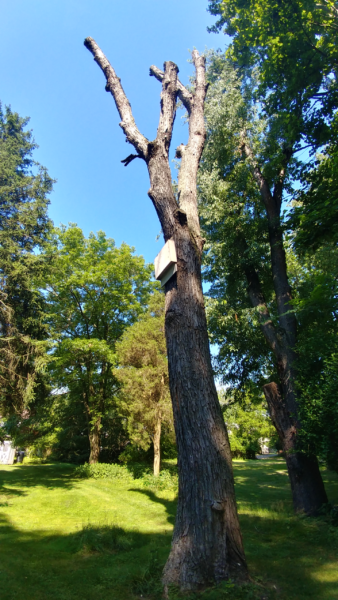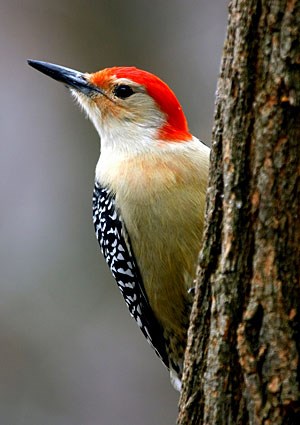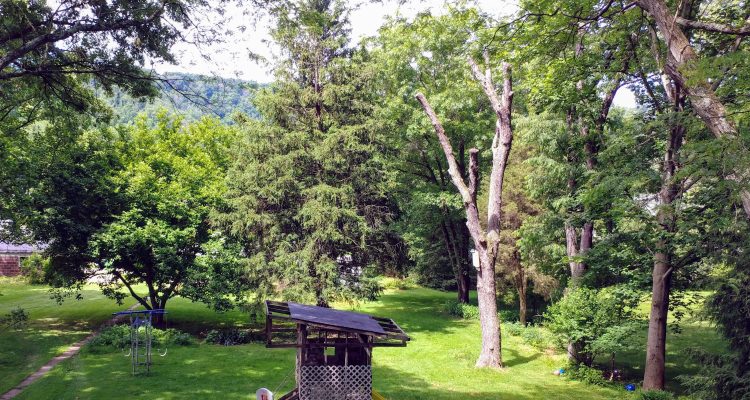Though I live in Wheeling, I’ve been blessed with a pretty big backyard. I don’t have to drive to Oglebay or beyond the city limits for open areas or shady groves. Over the course of our 100-plus years here on this family property, the generations have planted many trees. In the warming spring months, the canopy above unfolds like a Costa Rican rainforest. A wide variety of species grows here, including oak, ash, gum, walnut, poplar, sycamore, buckeye, elm, honey locust, dogwood, flowering crab, magnolia, hemlock, pine, spruce, and silver maple. And those are just the trees I can see from my porch.
Clearly, we have a thing for trees. But there’s one particular tree that garners most of the attention, and it’s the one visitors always ask about as they scan the yard. I’ve heard the same question rephrased many ways:
“Hey, do you know that tree in your yard is dead?”
“Uh, Laura? I don’t think your tree is coming back to life any time soon.”
“What’s the deal with that stumpy old tree down there? It doesn’t look so good.”
Thank you, everyone, but there’s no need to be subtle. My tree is definitely dead, and I do know it. And if you’d asked me about it a few years ago, I might have snapped at you and told you that we had plans to take it down. I’d have agreed that it was ugly, that it was an eyesore. A stark reminder of death amidst the vibrant green—what a blight on an otherwise lovely property. We named it Stumpy.
Stumpy used to be a giant silver maple, a stately guardian that blocked the late afternoon heat and sheltered the house from westerly storm winds. In the spring, it rained down its seed pods, call samaras, like tiny helicopters; in the fall, golden leaves fell in an annual cascade. But silver maples frequently suffer storm damage, as ours did during the derecho of June 29, 2012. (Truth be told, I think we all sustained damage during that event. Whether you lost a tree, a car, a roof, or sat in the sweltering dark with two toddlers watching your cell phone battery drop lower and lower until finally the Annoying Orange cartoon faded to black and a mournful cry rose up from your anguished soul, it was a rough few nights.)
Stumpy wasn’t the same after the derecho, and in the following year, large limbs began to come down, some nearly missing me and the kids as they fell on a calm, clear day. We called in an expert for an assessment, and he saw signs of disease. We decided to top the tree, hoping it would encourage new growth despite the poor prognosis. Topping is a practice that removes most of the upper limbs and, I have since learned, is an inadvisable way to handle a silver maple because it creates weak growth, damages the branching structure, and leaves the tree looking like a hat rack carved by a troop of drunken baboons.

Once Stumpy was topped, we sat around and watched it for a year or two, hoping new shoots might sprout. In the meantime, however, Nature sent in its own experts: fungi and woodpeckers. The former sprouted along the trunk; the latter, our resident red-bellied woodpecker pair, inspected the tree and decided they liked it enough to make it a home. Their presence indicated Stumpy housed a thriving insect community. The fungi indicated disease and decay.
In forestry terms, Stumpy had become a snag, a dead or dying tree. All signs pointed to its inevitable demise. This is the point at which most homeowners would have called the tree removal people. I, too, wanted to remove it, but as those woodpeckers spent more and more time on the tree (and less time pecking my house), I began to realize that it might have as much to give in death as it had in life.
Science backs me up on this. According to Dr. Leonard Perry, Horticulture Professor at the University of Vermont, “Birds and small mammals use snags for nests, food storage, foraging for insects (a staple of the diet for many birds), roosting, and merely perching. Hollow trunks, cavities and dead branches, even on living trees, provide similar ‘ecosystem resources’. Often wonder where birds go during storms and on cold winter nights? Many retreat to snags. If such trees are near waterways, when they drop limbs or fall into the water, these enhance aquatic habitats. Experts recommend at least three dead trees per acre to support wildlife. Nationwide, snags support over 1000 species of wildlife.”

So, it turns out that a dead tree may support more life than a living one. Stumpy provided the red-bellied woodpecker pair a place to feed and raise their young. This spring they began the long process of excavating a nest cavity. The chicks fledged at the end of May, and we watched from our deck as they hopped around on the old snag. We stood in awe as they took their first tentative test-flights and screamed in horror at their occasional downward plummets and subsequent narrow escapes from the jaws of our German shepherd. (There’s nothing quite so traumatic as gathering your kids for one of Nature’s miraculous events only to witness the dog barf up Woody Woodpecker’s partially-digested foot on the patio.)
After a pair of woodpeckers have finished raising their brood, the holes they carve continue to be of immense value to other animals, and a wide variety of species may move into the cavities in a snag. Cavity nesters in our area include but aren’t limited to bats, owls, squirrels, opossum, weasels, raccoons, and, if the cavity is large enough, black bears. Here in the valley, you probably won’t have to share your yard with a pair of cuddly cubs and their cantankerous mama, but you might see an increase in the number of birds. More birds means fewer insects, fewer weeds, better pollination, and an increased likelihood that you’ll sit down to watch them, drink some tea, and calm the heck down. Additionally, species who don’t live in the tree will still use the tree. Stumpy’s upper branches serve as a perch and a launch site for Cooper’s, Sharp-Shinned, and Red Tailed Hawks.
Nocturnal creatures can use the cavities in a snag as well. A screech owl will keep the rodent population down. One little brown bat will consume thousands of mosquitoes each night. To that end, we hung a bat house on Stumpy’s lower regions, roughly 15 feet off the ground. Our favorite fox squirrel uses the bat house as a place to nibble his nuts each morning.
Now, before you get too excited about this, remember that your next-door neighbor just sunk all his money into that 2014 Dodge Dart, so here’s a disclaimer about snags: Don’t be a dummy. Snags are great additions to property, but a dying or dead tree should be inspected by a professional to make sure it’s not going to fall. I mean, that dude freaks out when a bird poops on his windshield, right? He parks his car on the Wheeling Creek side of Kroger’s lot to avoid door dings. Don’t risk his wrath. Be safe and consult an expert. Once you’ve confirmed that your snag is stable, step back and let Nature do its thing.
Stumpy’s ugliness lies in the eyes of the beholder. Landscapers shudder when they come to work on my boxwoods. I’ve seen prune-happy types—the folks who like an even, weedless lawn and perfectly-shaped azaleas—break out in visible hives when they see that gangly gray skeleton towering in the western sky. I did too, for several years. I admit it: Stumpy drove me nuts and I was determined to take it down. Fortunately for the little souls who make their animal homes in my yard, I realized the importance of a varied backyard habitat. The tree has become the focal point of our porch view these days because there’s always some creature putting it to good use.
So, if you stop by, take a minute to appreciate the role our snag plays here in the Roberts backyard biome. As far as I’m concerned, Stumpy can stay.




